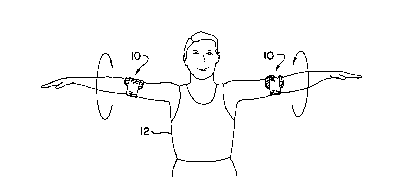Some of the information on this Web page has been provided by external sources. The Government of Canada is not responsible for the accuracy, reliability or currency of the information supplied by external sources. Users wishing to rely upon this information should consult directly with the source of the information. Content provided by external sources is not subject to official languages, privacy and accessibility requirements.
Any discrepancies in the text and image of the Claims and Abstract are due to differing posting times. Text of the Claims and Abstract are posted:
| (12) Patent: | (11) CA 2119338 |
|---|---|
| (54) English Title: | SELECTIVE MUSCLE EXERCISER |
| (54) French Title: | EXERCISEUR POUR MUSCLE SPECIFIQUE |
| Status: | Expired and beyond the Period of Reversal |
| (51) International Patent Classification (IPC): |
|
|---|---|
| (72) Inventors : |
|
| (73) Owners : |
|
| (71) Applicants : |
|
| (74) Agent: | BORDEN LADNER GERVAIS LLP |
| (74) Associate agent: | |
| (45) Issued: | 1999-12-14 |
| (22) Filed Date: | 1994-03-17 |
| (41) Open to Public Inspection: | 1995-05-13 |
| Examination requested: | 1995-11-20 |
| Availability of licence: | N/A |
| Dedicated to the Public: | N/A |
| (25) Language of filing: | English |
| Patent Cooperation Treaty (PCT): | No |
|---|
| (30) Application Priority Data: | None |
|---|
An exercising device with side-by-side external weights that are movable relative to each other so as to permit the device to assume a circular curvature in encircling relation about a limb of the user, this assumed curvature being used to advantage to position the device in overlying relation to a selected specific muscle for development of that muscle rather than for merely gross limb motion exercises as now results from a wrist, ankle or waist location.
Un dispositif d'exercice avec des poids externes côte à côte qui sont mobiles l'un par rapport à l'autre afin de permettre à l'appareil d'assumer une courbure circulaire dans une relation encerclant un membre de l'utilisateur, cette courbure étant mise à profit pour positionner l'appareil dans une relation recouvrant un muscle spécifique sélectionné pour le développement de ce muscle plutôt que pour les exercices grossiers de mouvement du membre tels que ceux résultant d'un placement sur les poignets, les chevilles ou la taille.
Note: Claims are shown in the official language in which they were submitted.
Note: Descriptions are shown in the official language in which they were submitted.

2024-08-01:As part of the Next Generation Patents (NGP) transition, the Canadian Patents Database (CPD) now contains a more detailed Event History, which replicates the Event Log of our new back-office solution.
Please note that "Inactive:" events refers to events no longer in use in our new back-office solution.
For a clearer understanding of the status of the application/patent presented on this page, the site Disclaimer , as well as the definitions for Patent , Event History , Maintenance Fee and Payment History should be consulted.
| Description | Date |
|---|---|
| Time Limit for Reversal Expired | 2014-03-18 |
| Letter Sent | 2013-03-18 |
| Grant by Issuance | 1999-12-14 |
| Inactive: Cover page published | 1999-12-13 |
| Inactive: Final fee received | 1999-09-09 |
| Small Entity Declaration Determined Compliant | 1999-09-09 |
| Pre-grant | 1999-09-09 |
| Notice of Allowance is Issued | 1999-06-04 |
| Notice of Allowance is Issued | 1999-06-04 |
| Letter Sent | 1999-06-04 |
| Inactive: Cover page published | 1999-06-01 |
| Inactive: Adhoc Request Documented | 1999-06-01 |
| Inactive: Prior art correction | 1999-06-01 |
| Inactive: Status info is complete as of Log entry date | 1999-06-01 |
| Inactive: Application prosecuted on TS as of Log entry date | 1999-06-01 |
| Inactive: Approved for allowance (AFA) | 1999-05-11 |
| Request for Examination Requirements Determined Compliant | 1995-11-20 |
| All Requirements for Examination Determined Compliant | 1995-11-20 |
| Application Published (Open to Public Inspection) | 1995-05-13 |
There is no abandonment history.
The last payment was received on 1999-02-23
Note : If the full payment has not been received on or before the date indicated, a further fee may be required which may be one of the following
Please refer to the CIPO Patent Fees web page to see all current fee amounts.
| Fee Type | Anniversary Year | Due Date | Paid Date |
|---|---|---|---|
| MF (application, 4th anniv.) - small | 04 | 1998-03-17 | 1998-01-28 |
| MF (application, 5th anniv.) - small | 05 | 1999-03-17 | 1999-02-23 |
| Final fee - small | 1999-09-09 | ||
| MF (patent, 6th anniv.) - small | 2000-03-17 | 2000-02-22 | |
| MF (patent, 7th anniv.) - small | 2001-03-19 | 2001-02-21 | |
| MF (patent, 8th anniv.) - small | 2002-03-18 | 2002-01-22 | |
| MF (patent, 9th anniv.) - small | 2003-03-17 | 2003-02-20 | |
| MF (patent, 10th anniv.) - small | 2004-03-17 | 2004-01-30 | |
| MF (patent, 11th anniv.) - small | 2005-03-17 | 2005-02-02 | |
| MF (patent, 12th anniv.) - small | 2006-03-17 | 2006-03-07 | |
| MF (patent, 13th anniv.) - small | 2007-03-19 | 2007-02-06 | |
| MF (patent, 14th anniv.) - small | 2008-03-17 | 2008-01-28 | |
| MF (patent, 15th anniv.) - standard | 2009-03-17 | 2009-02-24 | |
| MF (patent, 16th anniv.) - standard | 2010-03-17 | 2010-01-26 | |
| MF (patent, 17th anniv.) - standard | 2011-03-17 | 2011-03-02 | |
| MF (patent, 18th anniv.) - standard | 2012-03-19 | 2012-02-28 |
Note: Records showing the ownership history in alphabetical order.
| Current Owners on Record |
|---|
| EDITH WINSTON |
| Past Owners on Record |
|---|
| None |